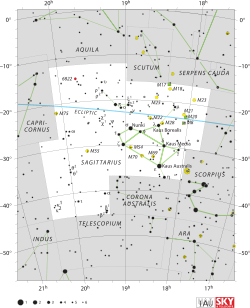Lambda Sagittarii

Location of λ Sagittarii (circled) | |
| Observation data Epoch J2000.0 Equinox J2000.0 | |
|---|---|
| Constellation | Sagittarius |
| Right ascension | 18h 27m 58.24072s[1] |
| Declination | −25° 25′ 18.1146″[1] |
| Apparent magnitude (V) | +2.82[2] |
| Characteristics | |
| Spectral type | K0 IV[3] |
| U−B color index | +0.903[4] |
| B−V color index | +1.045[4] |
| Astrometry | |
| Radial velocity (Rv) | −43.5[2] km/s |
| Proper motion (μ) | RA: −44.76[1] mas/yr Dec.: −185.66[1] mas/yr |
| Parallax (π) | 41.72 ± 0.16[1] mas |
| Distance | 78.2 ± 0.3 ly (23.97 ± 0.09 pc) |
| Details | |
| Mass | 2.6[5] M☉ |
| Radius | 11[6] R☉ |
| Surface gravity (log g) | 2.90[7] cgs |
| Temperature | 4,770[7] K |
| Metallicity [Fe/H] | –0.20[8] dex |
| Rotational velocity (v sin i) | 3.81[7] km/s |
| Other designations | |
Lambda Sagittarii (Lambda Sgr, λ Sagittarii, λ Sgr) is the Bayer designation for a star within the southern constellation of Sagittarius. The star marks the top of the Archer's bow, whence its traditional name Kaus Borealis.
With an apparent visual magnitude of +2.82,[2] this is one of the brighter members of the constellation and, accordingly to the Bortle Dark-Sky Scale, it is readily visible to the naked eye. Based upon parallax measurements, it is located at a distance of 78.2 light-years (24.0 parsecs) from Earth.[1] Being near the ecliptic, Lambda Sgr is sometimes occulted by the Moon and, more rarely, by a planet. The last planet to pass in front of it was Venus, on 19 November 1984. The previous occasion was on 5 December 1865, when it was occulted by the planet Mercury.
Kaus Borealis is a subgiant star with a stellar classification of K0 IV.[3] It has a mass 2.6 times that of the Sun.[5] The interferometry-measured angular diameter of this star, after correction for limb darkening, is 4.24 ± 0.05 mas.[9] At the estimated distance of Lambda Sagittarii,[1] this yields a physical size of about 11 times the radius of the Sun.[6] This expanded outer envelope is radiating energy at an effective temperature of 4,770 K,[7] causing it to glow with the cool orange hue of a K-type star.[10] It appears to be rotating at a leisurely rate, with a projected rotational velocity of 3.81 km s–1.[7]
Name and etymology
- The name Kaus Borealis comes from the Arabic قوس qaws 'bow' and Latin boreālis 'northern'.
- This star, together with γ Sgr, δ Sgr, ε Sgr, ζ Sgr, σ Sgr, τ Sgr and φ Sgr consisting the asterism Teapot.[11][12]
- This star is Al Tizini's Rāʽi al Naʽāïm (ألراع ٱلنعم), the Keeper of the Naʽams (Ostrich), meaning the "keeper" the two asterisms Al Naʽām al Wārid (النعم الوارد), "The Going Ostriches" and Al Naʽām al Ṣādirah (النعم السادرة), "The Returning Ostriches".[13]
- In Chinese, 斗 (Dǒu), meaning Dipper, refers to an asterism consisting of λ Sagittarii, φ Sagittarii, μ Sagittarii, σ Sagittarii, τ Sagittarii and ζ Sagittarii. Consequently, λ Sagittarii itself is known as 斗宿二 (Dǒu Sù èr, English: the Second Star of Dipper.)[14]
References
- ↑ 1.0 1.1 1.2 1.3 1.4 1.5 1.6 van Leeuwen, F. (November 2007), "Validation of the new Hipparcos reduction", Astronomy and Astrophysics 474 (2): 653–664, arXiv:0708.1752, Bibcode:2007A&A...474..653V, doi:10.1051/0004-6361:20078357.
- ↑ 2.0 2.1 2.2 Wielen, R. et al. (1999), Sixth Catalogue of Fundamental Stars (FK6). Part I. Basic fundamental stars with direct solutions (35), Astronomisches Rechen-Institut Heidelberg, Bibcode:1999VeARI..35....1W.
- ↑ 3.0 3.1 Gray, R. O. et al. (July 2006), "Contributions to the Nearby Stars (NStars) Project: Spectroscopy of Stars Earlier than M0 within 40 parsecs: The Northern Sample I", The Astronomical Journal 132 (1): 161–170, arXiv:astro-ph/0603770, Bibcode:2006AJ....132..161G, doi:10.1086/504637.
- ↑ 4.0 4.1 Gutierrez-Moreno, Adelina et al. (1966), A System of photometric standards 1, Publicaciones Universidad de Chile, Department de Astronomy, pp. 1–17, Bibcode:1966PDAUC...1....1G.
- ↑ 5.0 5.1 Edvardsson, B. (January 1988), "Spectroscopic surface gravities and chemical compositions for 8 nearby single sub-giants", Astronomy and Astrophysics 190 (1-2): 148–166, Bibcode:1988A&A...190..148E.
- ↑ 6.0 6.1 Lang, Kenneth R. (2006), Astrophysical formulae, Astronomy and astrophysics library 1 (3 ed.), Birkhäuser, ISBN 3540296921. The radius (R*) is given by:
- ↑ 7.0 7.1 7.2 7.3 7.4 Hekker, S.; Meléndez, J. (2007), "Precise radial velocities of giant stars. III. Spectroscopic stellar parameters", Astronomy and Astrophysics 475 (3): 1003–1009, arXiv:0709.1145, Bibcode:2007A&A...475.1003H, doi:10.1051/0004-6361:20078233.
- ↑ McWilliam, Andrew (December 1990), "High-resolution spectroscopic survey of 671 GK giants. I - Stellar atmosphere parameters and abundances", Astrophysical Journal Supplement Series 74: 1075–1128, Bibcode:1990ApJS...74.1075M, doi:10.1086/191527.
- ↑ Richichi; Percheron, I.; Khristoforova, M. (February 2005), "CHARM2: An updated Catalog of High Angular Resolution Measurements", Astronomy and Astrophysics 431: 773–777, Bibcode:2005A&A...431..773R, doi:10.1051/0004-6361:20042039.
- ↑ "The Colour of Stars", Australia Telescope, Outreach and Education (Commonwealth Scientific and Industrial Research Organisation), December 21, 2004, retrieved 2012-01-16.
- ↑ "Sagittarius". deepsky.astroinfo.org. Retrieved 30 August 2008.
- ↑ skywatchers
- ↑ Allen, R. H. (1963). Star Names: Their Lore and Meaning (Reprint ed.). New York: Dover Publications Inc. p. 355. ISBN 0-486-21079-0. Retrieved 2012-09-04.
- ↑ (Chinese) AEEA (Activities of Exhibition and Education in Astronomy) 天文教育資訊網 2006 年 5 月 11 日
External links
| ||||||||||||||||||||||||||
